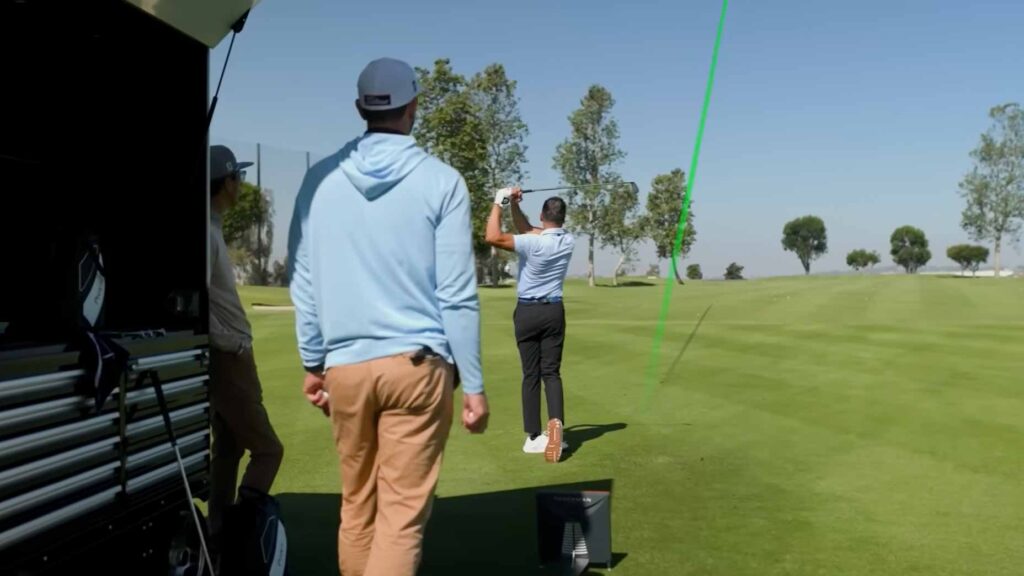Any clubfitter worth their salt will tell you that data should always guide your equipment choices. After all, the numbers don’t lie — shot data often reveals swing tendencies that most golfers could never spot on their own.
By analyzing key metrics, clubfitters can identify the equipment that compliments your unique swing, and dial in a setup that unlocks real performance gains, which is especially crucial with your scoring clubs, aka your irons.
To find out how this works at the highest level, GOLF’s director of equipment, Johnny Wunder, recently traveled to the Titleist Performance Institute, which is home to one of the most elite clubfitting experiences in the game.
Wunder worked with Titleist clubfitter Lucas Bro for a firsthand look at their process. What he found was wildly informative for any golfer looking to get the most out of a fitting.
The 3D’s of iron testing
One of the lesser-known pillars of Titleist’s fitting process is its 3D’s approach. According to Bro, this data-driven fitting method evaluates irons based on three critical metrics: distance, dispersion and descent angle.
These three metrics form the foundation of every iron fitting.
“It comes back to this singular goal,” Bro says, “If you can stop a golf ball on a green, on a more challenging surface, from a further distance away, in theory, you will shoot lower scores.”
Let’s break down how each “D” plays a role.
Distance
While most amateurs chase distance, Bro says that shouldn’t be the priority. Instead, fitters focus on distance consistency — specifically, how reliable your carry yardages are throughout the bag.
This involves dialing in ball-speed stability. Titleist’s fitters analyze how tight a player’s ball speeds are on both center and off-center hits. The goal? Flat-line ball speeds that result in flat-line carry distances.
“When you’re fitting a 7-iron, you’re looking to squeeze your ball speeds as tight as possible on on center hits and off-center hits,” Bro says. “If your ball speeds are flatlined, you will typically have flatline carry distances.”
Essentially, if your ball speed remains stable, your carry distance will, too.
The second layer of distance fitting is set composition, or how well your clubs are spaced out from a gapping perspective.
“The end goal to that is you want every club to maintain the same peak height,” Bro says. “If you hit your 7-iron 100 feet in the air, you should be able to hit your 4-iron 100 feet in the air.
“The physics behind it, the math is, every club should separate by about five miles an hour.”
Bro says that, from a physics standpoint, there should be about five miles per hour of ball speed separation between each club. This ensures not only proper yardage gaps but also consistent launch windows and trajectories across the set. The result? A well-balanced bag that instills confidence so you can attack more greens.
Dispersion
Dispersion patterns are a critical piece of the fitting puzzle. Experts like Bro use dispersion data to evaluate how forgiving a clubhead is, how well it suits a player’s strike pattern and where mishits tend to occur.
Smaller dispersion equals more predictability, and that leads to better scoring.
Descent angle
Descent angle might be overlooked by many golfers, but experts like Bro will tell you it’s the key to lower scores. A steeper descent angle helps you stop the ball faster on the green, especially from long range.
Bro says that this sometimes requires players to sacrifice a few yards to prioritize spin and height.
“The golf ball can only do four things. It has speed, it has launch, it has backspin and it has dispersion,” Bro says. “So [the ball’s] angle into the ground is one of the biggest determining factors for how quickly it can stop.”
“If I make your 7-iron too hot, too low spin, too flat in flight, all I do is make my job really hard when I get to the 4-iron,” he says, “So everything that I’m doing in the 7-iron, I’m thinking ahead a couple steps.”
Every club is fitted with the full set in mind.
Elite club fitting isn’t about chasing numbers — it’s about making them work for you. Titleist’s 3D approach allows expert fitters like Bro to translate data into a perfectly balanced set, tailored to your swing.
Titleist 2025 T150 Custom Irons
T150 Irons are crafted for added distance with unwavering accuracy. Forged into a player’s shape with progressive blade lengths, T150 offers a precise blend of speed, stability, and consistency—providing the confidence to hit and hold greens from anywhere.
Confidence-Inspiring Forged Design
Forged into a player’s shape with a slightly larger head size for pure feel with extra stability.
Elevated Ball Speed
1° stronger lofts (vs. T100) combine with an improved muscle channel through 7-iron and lower long-iron CG to help improve speed, launch, and carry.
Superior Flight and Stability
Split high-density tungsten produces optimal CG with remarkable stability for precise shotmaking.
Consistent Speed & Spin
New VFT technology and progressive groove design provide consistent spin and speed across the face in variable conditions.
View Product
Discover more from 6up.net
Subscribe to get the latest posts sent to your email.


